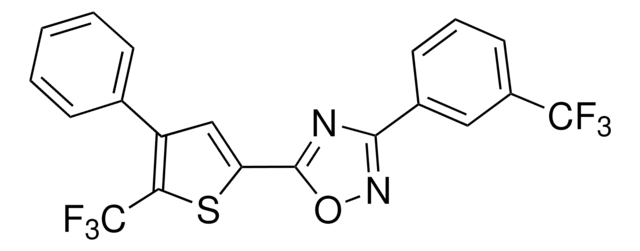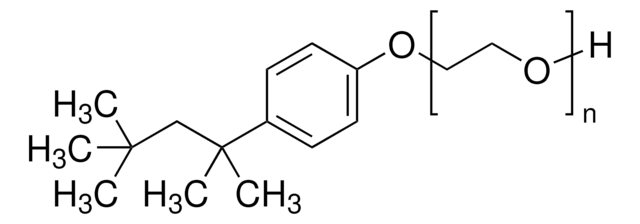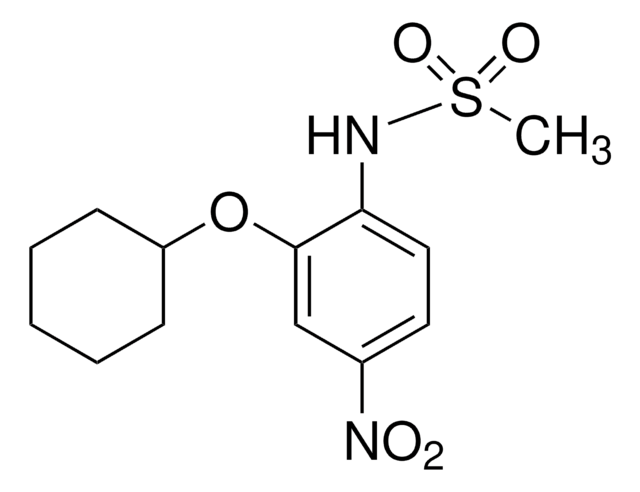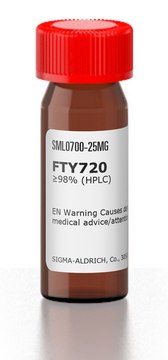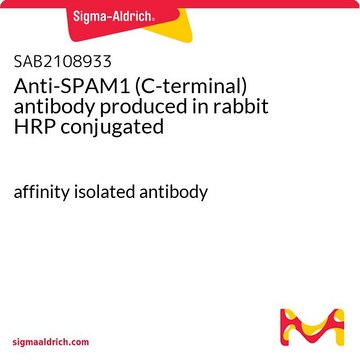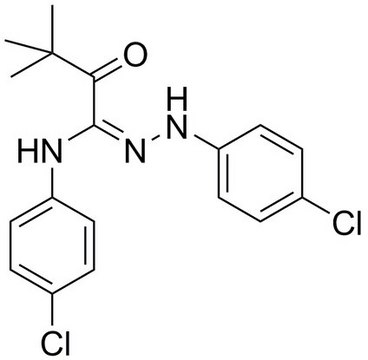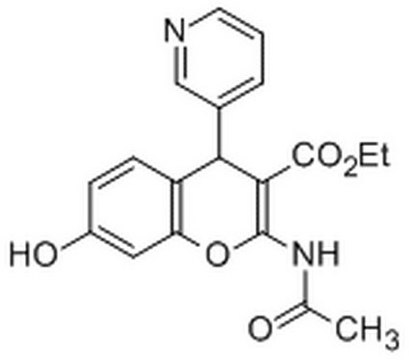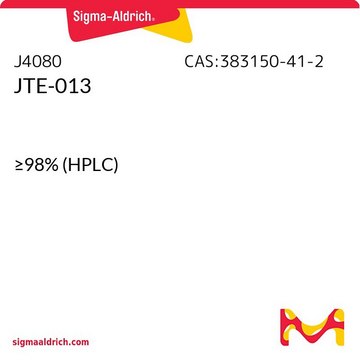SML2499
TY-52156
≥98% (HPLC)
别名:
1-(4-Chlorophenylamino)-1-(4-chlorophenylhydrazono)-3,3-dimethyl-2-butanone, 1-(4-Chlorophenylhydrazono)-1-(4-chlorophenylamino)-3,3-dimethyl-2-butanone, N-(4-Chloroanilino)-N′-(4-chlorophenyl)-3,3-dimethyl-2-oxobutanimidamide, TY 52156, TY52156
登录查看公司和协议定价
所有图片(1)
About This Item
推荐产品
方案
≥98% (HPLC)
表单
powder
颜色
white to very dark brown
溶解性
DMSO: 2 mg/mL, clear
储存温度
2-8°C
SMILES字符串
CC(C)(C(/C(NC1=CC=C(C=C1)Cl)=N/NC2=CC=C(C=C2)Cl)=O)C
InChI
1S/C18H19Cl2N3O/c1-18(2,3)16(24)17(21-14-8-4-12(19)5-9-14)23-22-15-10-6-13(20)7-11-15/h4-11,22H,1-3H3,(H,21,23)
InChI key
XONRRGIRSGNWFP-UHFFFAOYSA-N
生化/生理作用
Orally active, potent and selective sphingosine 1-phosphate (S1P) receptor 3 (S1P3; S1PR3) antagonist with in vitro and in vivo efficacy.
TY-52156 is a potent sphingosine 1-phosphate (S1P) receptor 3 (S1P3; S1PR3) antagonist that selectively inhibits S1P-stimulated Ca2+ response in human S1P3-expressing cells (Ki = 110 nM) and Eu-GTP binding to S1P3-containing membranes over those of S1P1/2/4/5. TY-52156 inhibits S1P3-dependent signaling events in human coronary artery smooth muscle cells (1 μM), S1P3-dependent coronary flow decrease in perfused rat hearts, as well as S1P3-mediated acute mechanical pain in mice (10 nmol/20 μL/paw id.) and bradycardia in anesthetized rats (30 mg/kg TY-52156 p.o.) in vivo with good oral bioavailability (F = 70.9%; 1 mg/kg p.o. in rats).
储存分类代码
11 - Combustible Solids
WGK
WGK 3
闪点(°F)
Not applicable
闪点(°C)
Not applicable
历史批次信息供参考:
分析证书(COA)
Lot/Batch Number
Shushu Wang et al.
Medical science monitor : international medical journal of experimental and clinical research, 24, 1912-1923 (2018-04-02)
BACKGROUND Triple negative breast cancer (TNBC) has a more aggressive recurrence. Previous reports have demonstrated that sphingosine kinase 1 (SphK1) is a crucial regulator of breast cancer progression. However, the correlation of SphK1 with clinical prognosis has been poorly investigated.
Iuliia Filipenko et al.
Biochimica et biophysica acta, 1861(11), 1840-1851 (2016-09-13)
Breast cancer is one of the most common and devastating malignancies among women worldwide. Recent evidence suggests that malignant progression is also driven by processes involving the sphingolipid molecule sphingosine 1-phosphate (S1P) and its binding to cognate receptor subtypes on
Akira Murakami et al.
Molecular pharmacology, 77(4), 704-713 (2010-01-26)
Sphingosine 1-phosphate (S1P) induces diverse biological responses in various tissues by activating specific G protein-coupled receptors (S1P(1)-S1P(5) receptors). The biological signaling regulated by S1P(3) receptor has not been fully elucidated because of the lack of an S1P(3) receptor-specific antagonist or
Xiao-Jing Sun et al.
Journal of cellular and molecular medicine, 22(3), 1769-1777 (2017-11-24)
Cumulating evidences suggested an important role of sphingosine-1-phosphate (S1P) and its receptors in regulating endothelial barrier integrity. Our previous study revealed that the circulating S1P levels and renal expression of S1PRs correlated with disease activity and renal damage in patients
Zhijing Zhao et al.
Experimental and therapeutic medicine, 15(6), 5007-5016 (2018-05-29)
Thyroid carcinoma is characterized by an aggressive behavior, lack of effective targeted therapies and a high rate of relapse. Sphingosine kinase 1 (SPHK1) has been reported to be a critical regulatory factor in the progression of thyroid carcinoma, but the
我们的科学家团队拥有各种研究领域经验,包括生命科学、材料科学、化学合成、色谱、分析及许多其他领域.
联系技术服务部门
